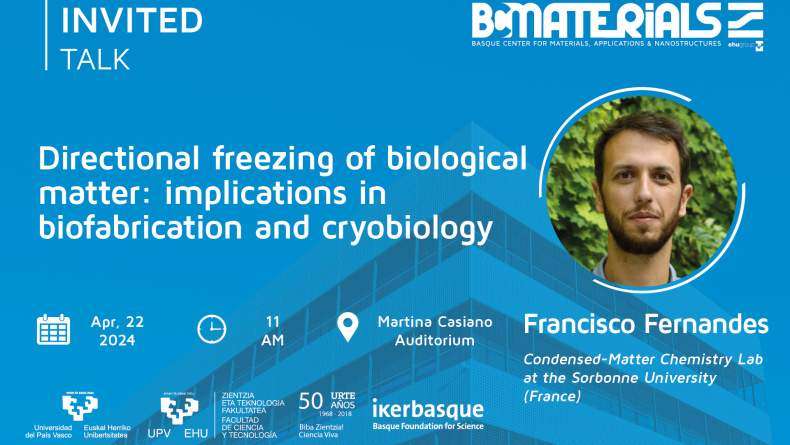BCMaterials Fortnightly Seminar #89 Anabel Pérez - Lourdes Marcano

ANABEL PÉREZ
(BCMATERIALS)
Ni-Mn-Ga high temperature shape memory alloys: Functional stability in β and β + γ regions
A growing interest has recently arisen in the development of high temperature SMAs (HTSMAs), working up to 550 ºC, as a response to the demand from the different highly technological areas, such as automotive or aerospace industries. Currently, the FeMnSi-, CuAlNi-, NiMn-, NiAl-, Ti(Pt, Pd, Au)- and NiTi-based alloys systems are under intense research as HTSMAs candidates. While many of these systems exhibit a high temperature MT, no real breakthrough has been made yet in their actuation capability at high temperatures, due to issues like martensite stabilization, low strain output, thermal and thermomechanical instability, etc. Record-breaking values of the tensile superelastic strain (about 12%) have been found previously in Ni-Mn-Ga single crystalline alloys at 400 ºC which placed such materials ahead of known high temperature shape memory alloys (HTSMAs) promising in the automotive or aerospace industries operating in the range of 400-500 ºC and above. The aim of this work was to elaborate Ni-Mn-Ga HTSMAs with MT higher than 400 ºC exhibiting a stabilized actuation response of nearly 4% strain, after a cyclic training. Our approach to reach this goal was to explore different compositions of these alloys that show either a single β phase or a dual β + ϒ phase, and to study the mechanisms leading to the cycling stability (thermal and thermomechanical) in single crystal and polycrystalline forms. The influence of annealing (prior to a thermomechanical cycling) on the transformation characteristics of the single crystalline samples was also examined.The results addresses two main issues that commonly affect Ni-Mn-Ga HTSMAs and limit their application, namely cycling stability of the transformation temperatures and thermomechanical actuation.
LOURDES MARCANO
(BCMATERIALS)
Magnetic Anisotropy Rules the Helical Shape of the Magnetosome Chain Assembled by Magnetospirillum gryphiswaldense
Magnetospirillum gryphiswaldense is a microorganism able to biomineralize high quality magnetite nanoparticles, called magnetosomes. These helical cells contain a variable number of 45 nm cuboctahedral single domain magnetite magnetosomes arranged in a chain. Thus, the chain behaves like a large single permanent magnetic dipole able to orient the whole cell along earth magnetic field. In this sense, magnetosome chain is a natural paradigm of 1D magnetic nanostructure. Due to the large magnetic anisotropy, such arrangements show potential for biomedical applications and actuation devices as nanorobots. Rather than the a priori expected straight lines, magnetosome chains are slightly bent. The present work sheds light on the underlying mechanisms that determine the arrangement of the magnetosomes and consequently the geometry of the chain. We have explored the direction of the magnetic moment using state-of-the-art techniques on a set of different bacterial arrangements: i) small angle neutron/x-ray scattering (SANS/SAXS) on a bacterial colloid, ii) macroscopic magnetometry on 3D and 2D fixed arrangements of randomly distributed and aligned bacteria, and iii) x-ray photoemission electron microscopy (XPEEM) on an individual chain of magnetosomes extracted from bacteria. Our experimental and theoretical findings suggest that due to the competition between the magnetocrystalline and shape anisotropies, the effective magnetic moment of individual magnetosomes is 20° tilted out of the chain axis ([111] crystallographic easy axis of Fe3O4). This tilt does not affect the direction of the chain net magnetic moment, which remains along the chain axis, but turns out to be the key to understand the arrangement of magnetosomes in helical-shaped chains. In fact, by considering interplay between the magnetic dipolar interactions between magnetosomes and a lipid/protein-based mechanism, modelled as an elastic recovery force exerted on the magnetosomes, we were able to reproduce the experimental chain geometry imaged by cryotomography.Related news
Charla invitada de Joel Villatoro el 25 de abril
El próximo 25 de abril BCMaterials recibirá al Dr. Joel Villatoro como nuevo conferenciante invitado con la charla titulada “"All-Optical Fiber Sensing". La charla comenzará a las 10:00 horas en el...Eloie Gallego, nueva Asistente Técnica de Investigación
BCMaterials da la bienvenida a Eloie Gallego, que se incorpora a nuestro centro como nueva Asistente Técnico de Investigación. Trabajará dando servicio a una creciente actividad de laboratorio en...Charla invitada con Francisco Fernandes el 22 de abril
BCMaterials ofrecerá una nueva charla invitada el próximo 22 de abril con Francisco Fernandes, profesor asociado del Laboratorio de Química de la Materia Condensada de la Universidad de la Sorbona (...Jorge Saiz, nuevo investigador Ramón y Cajal en BCMaterials
BCMaterials se felicita por la incorporación de Jorge Saiz Galindo como nuevo investigador post-doctoral Ramón y Cajal Fellow. Saiz obtuvo su licenciatura en Biología y su doctorado en la...



